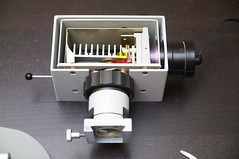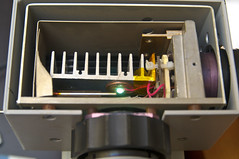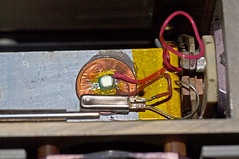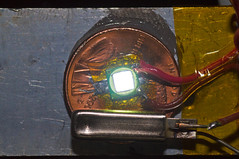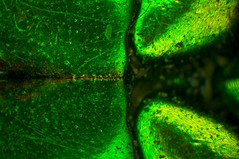LED microscope lighting 2
Problem Statement
I recently aquired a Reichert metallurgical reflected light microscope. The scope is a beast and weighs far too much for field use. Due to the light requirements of polarized reflected light microscopy, the lamp housing is a high wattage tungsten halogen bulb (100W) in an external housing and an external (and massive) dimmer box. Assuming a quartz halogen bulb, we can assume a luminous efficiency of ~24 lm / watt or 2400 lumins. This is then filtered by the blue filter and the frosted glass screen.
I would like to convert this to LED lighting for three reasons.
- The variable color temperature of tunsgten halogen bulbs makes photography frustrating. The color cast can be corrected in photography by matching white balance but this is only constant for a single brightness setting.
- The amount of heat that the bulb emits when set to full brightness is quite amazing. Touching the radiator fins is not possible due to the heat and that makes me nervous when working with microscopy related volatile compounds such as alcohols or ethers. Not to mention IR sample heating.
- The dimmer box is a beast and likely houses some sort of autotransformer. Modern power LED drivers could be housed in a much smaller form or even directly attached to the housing.
System Overview
The LED and driver
The LED is a Cree XM-L which features 1,000 lumins of 125 Deg cool white light when driven at 3A. The driver is currently an 18V 2A power supply from circuit specialists. Dimming is achieved by using the current control knob. At full brightness, power LEDs gets toasty and in this case the die must be kept below 150°C. To sink this waste heat away, the LED is soldered to a penny which is attached to a large aluminum heat sink with Arctic Silver 5 thermal paste. The power pads on the bottom of the package are masked with kapton tape. However, in the event that this isn't enough there is a thermal cutoffsiwtch mounted to the penny which will disconnect the LED if the temperature rises over 90°C.
Results
1,000 lumins of white LED light is a new level in my experience with LED modded microscopes. Using the Reichert in transmitted light mode is not possible when using more than a few mA of LED power due to the sheer brightness. However, in reflected light modes, especially cross polarized darkfield, the full brightness of the LED is required. Of course, my driver can only reach the 2A mark until I build a dedicated driver for it.
2011 Jasper Nance KE7PHI

